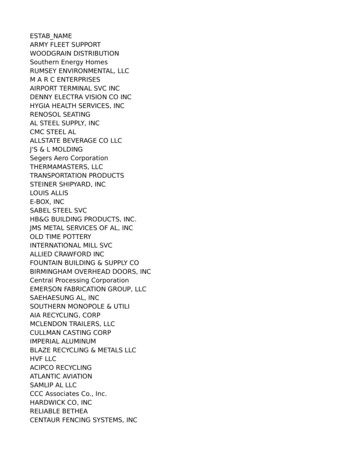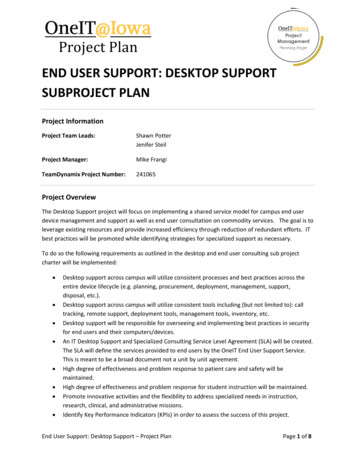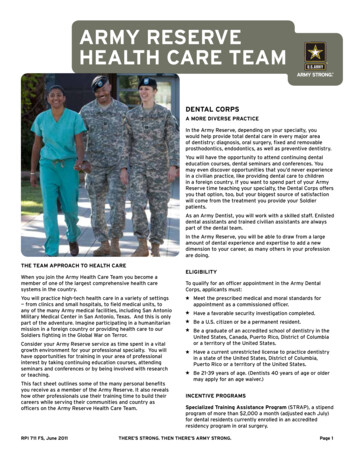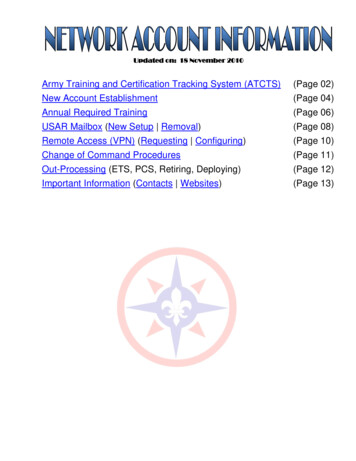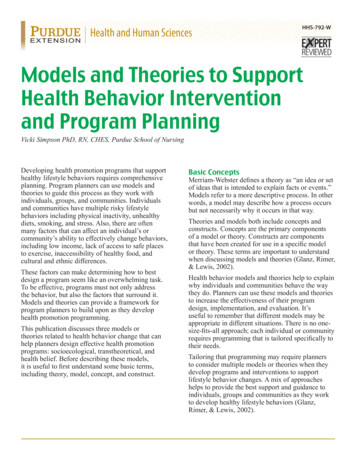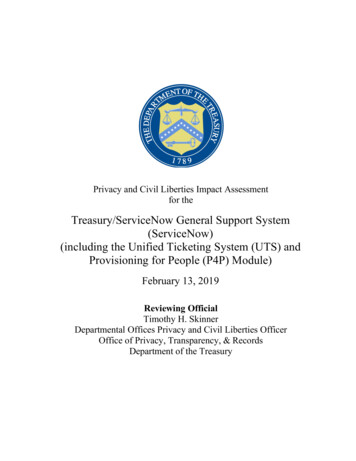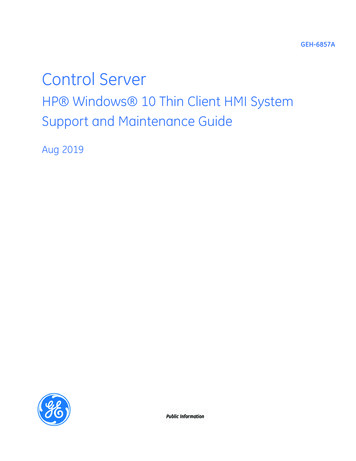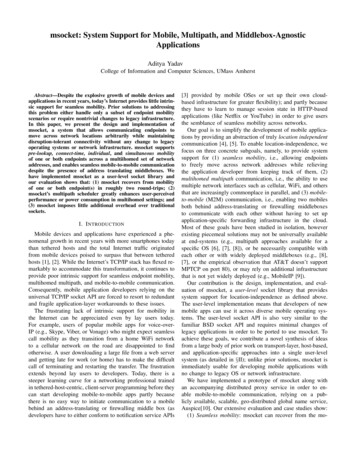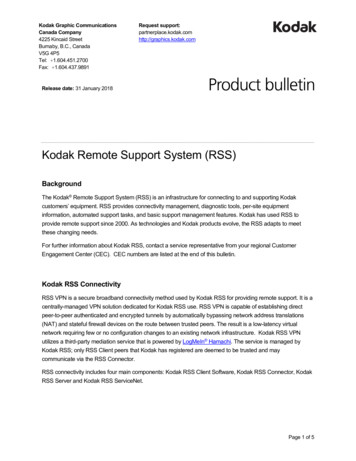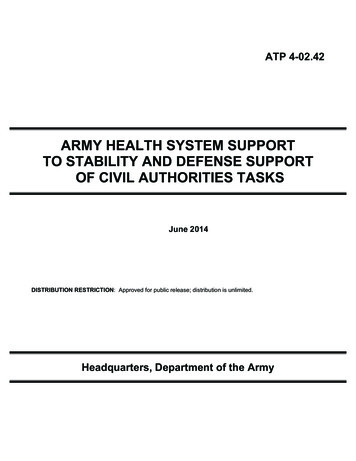
Transcription
ATP 4-02.42ARMY HEALTH SYSTEM SUPPORTTO STABILITY AND DEFENSE SUPPORTOF CIVIL AUTHORITIES TASKSJune 2014DISTRIBUTION RESTRICTION: Approved for public release; distribution is unlimited.Headquarters, Department of the Army
This publication is available at Army Knowledge .html).To receive publishing updates, please subscribe athttp://www.apd.army.mil/AdminPubs/new subscribe.asp.
*ATP 4-02.42HeadquartersDepartment of the ArmyWashington, DC, 9 June 2014Army Techniques PublicationNo. 4-02.42Army Health System Support to Stability andDefense Support of Civil Authorities TasksContentsPagePREFACE.vINTRODUCTION .viiPART ONEChapter 1ARMY HEALTH SYSTEM SUPPORT TO STABILITYSTABILITY OVERVIEW. 1-1Section I — Stability in Operations. 1-1Stability Principles . 1-1Primary Stability Tasks . 1-2Section II — Lead Federal Agency. 1-2Department of State . 1-2Section III — National Strategy and Defense Policies . 1-4National Strategy . 1-4Policy Documents . 1-4Section IV — Regional Focus . 1-6Theater Engagement Strategy . 1-6Theater Security Cooperation Plan . 1-6Chapter 2ESSENTIAL STABILITY TASKS . 2-1Section I — Primary Stability Tasks . 2-1Essential Task List. 2-1Section II — Establish Civil Security . 2-2Ensure Adequate Health, Food, and Security for Belligerents . 2-3Section III — Restore Essential Services . 2-4Provide for Immediate Humanitarian Needs of the Population . 2-5Ensure Sanitation, Purification, and Distribution of Drinking Water . 2-5Provide Interim Sanitation, Wastewater Management, and Waste DisposalServices . 2-5Distribution Restriction: Approved for public release; distribution is unlimited.*This publication supersedes FM 8-42, dated 27 October 1997.9 June 2014ATP 4-02.42i
ContentsSupport Famine Prevention and Emergency Food Relief Programs. 2-6Section IV — Support to Economic and Infrastructure Development . 2-8Protect Natural Resources and the Environment . 2-8Support General Infrastructure and Reconstruction Programs . 2-11Chapter 3ARMY HEALTH SYSTEM SUPPORT TO STABILITY TASKS . 3-1Section I — Building Partner Capacity . 3-1Medical Capacity Building . 3-1Health Care Program Development . 3-2Section II — Civil-Military Operations . 3-3Role of Civil Affairs in Stability . 3-3Section III — Legal Considerations . 3-4Eligibility Criteria. 3-4Standard of Care . 3-5Military Medical Training Considerations . 3-5Section IV – Medical Support to Stability Tasks . 3-5Army Medical Functions . 3-6Medical Mission Command Support to Stability Tasks . 3-6Medical Treatment (Organic and Area Support) Support to Stability Tasks . 3-8Hospitalization Support to Stability Tasks . 3-9Medical Evacuation and Regulating Support to Stability Tasks . 3-11Medical Logistics Support to Stability Tasks . 3-12Medical Laboratory Support to Stability Tasks . 3-13Dental Support to Stability Tasks . 3-14Preventive Medicine Support to Stability Tasks. 3-16Combat and Operational Stress Control Support to Stability Tasks . 3-20Veterinary Support to Stability Tasks . 3-20Chapter 4MEDICAL PLANNING FOR STABILITY. 4-1Section I — Planning for Contingency Operations . 4-1Section II — Transition and End State . 4-2Transition . 4-2Transition Planning for Medical Support to Stability . 4-2End State . 4-3Section III — Medical Planning Considerations for Stability . 4-4Foundations for Army Health System Support . 4-4Section IV — Army Health System Support to Joint Operations . 4-4Joint Operations . 4-4Military Engagements in Peacetime. 4-5PART TWOChapter 5ARMY HEALTH SYSTEM SUPPORT TO DEFENSE SUPPORTOF CIVIL AUTHORITIES TASKSDEFENSE SUPPORT OF CIVIL AUTHORITIES OVERVIEW . 5-1Section I — Defense Support of Civil Authorities . 5-1Primary Defense Support of Civil Authorities Tasks . 5-2Primary Characteristics . 5-2Section II — National and Defense Policy . 5-2iiATP 4-02.429 June 2014
ContentsNational Policy . 5-2Defense Policy . 5-3Section III — Primary Defense Support of Civil Authorities Tasks . 5-4Support for Domestic Disasters . 5-4Support for Domestic Chemical, Biological, Radiological, and NuclearIncidents . 5-5Support for Civilian Law Enforcement Agencies . 5-5Other Designated Support . 5-6Section IV — National Emergency Management . 5-6National Response Framework . 5-6National Disaster Recovery Framework . 5-6National Incident Management System. 5-7National Disaster Medical System . 5-8Chapter 6ARMY HEALTH SYSTEM SUPPORT TO DEFENSE SUPPORT OF CIVILAUTHORITIES TASKS . 6-1Section I — Department of Defense Medical Support for DomesticIncidents . 6-1Department of Defense Support to the National Disaster Medical System . 6-1Department of Defense Role Within the National Response Framework . 6-2Section II – Legal Considerations . 6-6Section III – Army Health System Support. 6-6Army Health System Support to Defense Support of Civil Authorities . 6-6Hospitalization . 6-7Medical Mission Command . 6-9Medical Treatment (Organic and Area Support) . 6-16Medical Evacuation . 6-16Medical Logistics . 6-19Medical Laboratory . 6-21Preventive Medicine . 6-22Combat and Operational Stress Control . 6-24Dental Support . 6-27Veterinary Support. 6-27Chapter 7INTERORGANIZATIONAL COORDINATION . 7-1Section I — Coordination Requirements . 7-1Section II — Coordination in Support of Stability Tasks. 7-1Governmental Agencies . 7-1Department of Defense . 7-2Multinational and Nongovernmental Organizations . 7-4Section III — Coordination in Support of Defense Support of CivilAuthorities . 7-5Requests for Department of Defense Assistance . 7-5Pre-Scripted Mission Assignments. 7-7National Disaster Medical System Requests for Assistance. 7-7Section IV — National Response Resources . 7-9Department of Health and Human Services . 7-9Food and Drug Administration . 7-129 June 2014ATP 4-02.42iii
ContentsSection V — National Response Framework Support Agencies . 7-12Support Agencies for Emergency Support Function #8. 7-12Department of Agriculture . 7-12Department of Commerce . 7-13Department of Energy . 7-13Department of Homeland Security . 7-14Department of the Interior . 7-15Department of Justice . 7-15Department of Labor . 7-15Department of State . 7-16Department of Transportation . 7-16Department of Veterans Affairs. 7-16Environmental Protection Agency . 7-17American Red Cross . 7-17Section VI — Other Emergency Response Resources . 7-18Emergency Alert System . 7-18Mobile Emergency Response Support . 7-19National Preparedness Network . 7-19Recovery Radio Support . 7-19Federal Emergency Management Agency National Shelter System. 7-19Radiation Emergency Assistance Center/Training Site . 7-20Appendix AARMY HEALTH SYSTEM SUPPORT ASSESSMENTS . A-1Appendix BSECTIONS OF TITLE 10, UNITED STATES CODE, PERTAINING TO FOREIGNHUMANITARIAN ASSISTANCE . B-1GLOSSARY . Glossary-1REFERENCES. References-1INDEX . Index-1FiguresFigure 2-1. Stability task alignment . 2-2Figure 6-1. Incident command structure . 6-12Figure A-1. Medical aspects of the operational variables . A-4Figure A-2. Civil affairs area study and assessment . A-6TablesTable 2-1. Medical considerations . 2-3Table 6-1. Department of Defense support to emergency support function #8 . 6-4Table 6-2. Department of Defense support to emergency support function #11 . 6-5Table 6-3. Critical information requests during the alerted phase . 6-15Table 6-4. Critical information requests during the activated phase . 6-15Table 6-5. Critical information requests during deactivation . 6-16Table 7-1. Mission assignment/request for assistance process . 7-8ivATP 4-02.429 June 2014
PrefaceThis ATP establishes Army Health System (AHS) support doctrine and provides the guiding principles for theprovision of medical support to stability and defense support of civil authorities (DSCA) tasks.The principal audience for this publication is commanders, their staffs, medical planners, and personnel at alllevels. Commanders, staffs, and subordinates ensure their decisions and actions comply with applicable UnitedStates (U.S.), international, and in some cases, host-nation laws and regulations. Commanders at all levelsensure their Soldiers operate in accordance with the law of war and the rules of engagement. (See FM 27-10.)This manual is a guide for providing AHS support to stability and DSCA tasks in an area of operations. Thispublication applies to the Active Army, Army National Guard/Army National Guard of the United States, andthe United States Army Reserve, unless otherwise stated.This publication implements or is in consonance with American, British, Canadian, Australian, and NewZealand (Armies) Standard 815, Blood Supply in the Area of Operations; Quadripartite Advisory Publication256, Coalition Health Interoperability Handbook; and the following North Atlantic Treaty OrganizationStandardization Agreements:TITLENUMBERMedical Employment of Air Transport in the Forward Area2087Allied Joint Medical Support Doctrine—Allied Joint Publication-4.10(A)2228Training Requirements for Health Care Personnel in International Missions—Allied Medical Publication-8.32249Allied Joint Doctrine for Civil-Military Cooperation—Allied Joint Publication-3.4.92509Allied Joint Doctrine for Non-Combatant Evacuation Operations—Allied JointPublication-3.4.22514Allied Joint Medical Planning Doctrine—Allied Joint Medical Publication-12542Allied Joint Civil-Military Medical Interface Doctrine—Allied Joint MedicalPublication-62563Army Techniques Publication 4-02.42 uses joint terms where applicable. Selected joint and Army terms anddefinitions appear in both the text and the glossary. This publication is not the proponent for any Army terms.Unless this publication states otherwise, masculine nouns and pronouns do not refer exclusively to men.The proponent of this publication is the U.S. Army Medical Department Center and School. The preparingagency is the Doctrine Literature Division, U.S. Army Medical Department Center and School. Send commentsand recommendations on a DA Form 2028 (Recommended Changes to Publications and Blank Forms) toCommander, U.S. Army Medical Department Center and School, ATTN: MCCS-FC-DL (ATP 4-02.42),2377 Greeley Road, Suite D, Building 4011, JBSA Fort Sam Houston, Texas 78234-7731; by e-mail octrine@mail.mil; or submit an electronic DA Form2028. All recommended changes should be keyed to the specific page, paragraph, and line number. A rationaleshould be provided for all recommended changes to aid in the evaluation and adjudication of each comment.9 June 2014ATP 4-02.42v
IntroductionArmy Techniques Publication 4-02.42 examines the various situations in which Army medical personnel maybe required to provide support for stability and DSCA tasks. While the Department of Defense (DOD) is not aprovider of first resort in disasters, requests for support from U.S. forces may be required when military-uniquecapabilities (such as lift capability, engineering, or deployable medical support) exist that can expedite reliefefforts during urgent, life-threatening situations.This manual is a two-part p
Medical Employment of Air Transport in the Forward Area 2087 Allied Joint Medical Support Doctrine—Allied Joint Publication-4.10(A) 2228 Training Requirements for Health Care Personnel in International Missions— Allied Medical Publication-8.3 2249 Allied Joint Doctrine for Civil-Military Cooperation—Allied Joint Publication-3.4.9 2509
